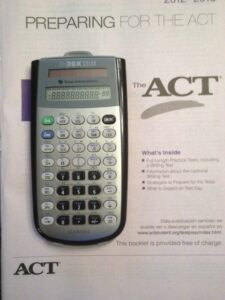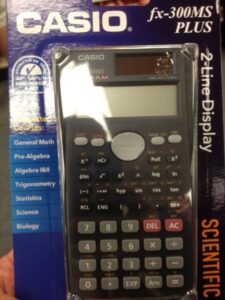What Calculators Are Allowed on the ACT: Common Mistakes to Avoid

(policies are current as of Jan 2023)
The ACT is this weekend and I’ve been making sure my private ACT tutoring clients have calculators that meet testing regulations. Although I’ve reminded them for weeks to pick up a calculator for the test, most hadn’t. So I’ve been handing out basic calculators so they can spend Saturday focusing on the test and applying the techniques they’ve learned. Do you know the common ACT calculator mistakes and how to avoid them?
ACT is NOT like the SAT
Last weekend my students took the SAT with whatever calculators they regularly use for school. Many have graphing calculators; the TI-89 and TI-Nspire CAS are the most common. For the SAT, I don’t sweat the calculator issue. Students should bring what they are most comfortable using. Not the case on the ACT.
ACT Has Strict Calculator Policies
The ACT presents a challenge because some of the most current and popular calculator models are not permitted. Here is the current list of prohibited calculators from the ACT website:
The following types of calculators are prohibited:
-
calculators with built-in computer algebra systems Prohibited calculators in this category include:
- Texas Instruments: All model numbers that begin with TI-89 or TI-92 and the TI-Nspire CAS—Note: The TI-Nspire (non-CAS) is permitted.
- Hewlett-Packard: HP Prime, HP 48GII, and all model numbers that begin with HP 40G, HP 49G, or HP 50G
- Casio: Algebra fx 2.0, ClassPad 300 and ClassPad 330, and all model numbers that begin with CFX-9970G
-
handheld, tablet, or laptop computers, including PDAs
-
electronic writing pads or pen-input devices—Note: The Sharp EL 9600 is permitted.
-
calculators built into cell phones or any other electronic communication devices
-
calculators with a typewriter keypad (letter keys in QWERTY format)—Note: Letter keys not in QWERTY format are permitted.
Students Can Be Dismissed for Using the Wrong Calculator
The ACT takes their calculator policy seriously. Many test administrators try to avoid problems by warning students prior to the test and collecting prohibited calculators. This results in students finding out minutes before the test that they will have to work all problems by hand. The worst-case scenario is starting the test with a prohibited calculator and having to leave as a result of this rule violation. ACT states:
Using the TI-89 is the most common reason students are dismissed from the ACT for prohibited calculator use.
Approved Alternatives
If your student owns one of the calculators on the prohibited list, you will want to look for approved alternatives.
Graphing Calculators
Although graphing capabilities are not necessary for ACT success, students accustomed to using a graphing calculator may want to find an acceptable replacement. TI-83 and TI-84 models are approved. Many schools have used these calculators in the classroom for years, so students are familiar with them. Unfortunately these models typically cost over $100, a poor investment if you only need it for ACT testing. Some students have been successful in checking a calculator out from their school for the weekend or borrowing from a friend. A current client of mine was able to find a graphing TI-84 at a pawn shop for $20.
Non-Graphing Models
My choice for the ACT is a standard, non-graphing, scientific calculator. The photo above is my “good” calculator. Usually I use a cheap dollar store model that can add, subtract, multiply, divide, and take a square root. But for the ACT, I like to have a model with a few more features including trig functions and logs. This is a calculator I used in my graduate statistics classes. Most calculators in this category cost between $10 and $20 and can be found at any office supply store or Target. Below is a picture of a calculator I found in my neighborhood CVS pharmacy.

Students don’t need a graphing calculator in order to succeed on the ACT. What they do need is an approved calculator with basic functions needed to complete test questions. Essentially, once students have an approved calculator they are familiar with, they can focus on the actual math part of the test. Success in math is not about which calculator a student uses; it is about the information they choose to input into the device.
zolie
Are TI-36 X Pro calculators allowed?
LAURA ZANDE
Is the Sharp El-501x allowed to be used on ACT.
Megan Dorsey
You can check on the ACT website: https://www.act.org/content/act/en/products-and-services/the-act/taking-the-test/calculator-policy.html
If you are still unsure, I recommend two things:
1. Call ACT and ask.
2. Bring a backup calculator on the day of the test in case you need it.
Wishing you the best on your ACT!
Megan
Will
Did you find out if the Sharp el-501x was acceptable?
Megan Dorsey
As long as it is NOT listed on this prohibited list, you can use it:
https://www.act.org/content/dam/act/unsecured/documents/ACT-calculator-policy.pdf
chaya
is the ti 36x solor allowed?
Shelby
Is the TI 84 calculator allowed
Megan Dorsey
Yes.
Ashley
I have a TI-30xIIS is that allowed?
Megan Dorsey
Ashley,
You should check with ACT. Here is their policy: https://www.act.org/content/dam/act/unsecured/documents/ACT-calculator-policy.pdf
Megan
J.D.
Is a Texas Instrument TI-81 allowed?
Megan Dorsey
It is always best to check with the ACT’s official policy: https://www.act.org/content/dam/act/unsecured/documents/ACT-calculator-policy.pdf
Megan
Dhennie
Is Casio fx-9750GII allowed?
Cam
Is the TI-84 plus CE allowed?
Mac
Is the Casio fx-9750GII allowed on the ACT.
Boon Kiat Sim
Hi, is the Texas Instrument BA II Plus Professional acceptable for use in the ACT Test?
Thanks
Rushabh Dhyani
Is Casio fox-991EX class wiz allowed on ACT test?
Maria
Hello! Is a CITIZEN sr-260 allowed?
Megan Dorsey
Maria– check the ACT calculator policy: https://www.act.org/content/dam/act/unsecured/documents/ACT-calculator-policy.pdf
When in doubt, call the number listed on that page and ask.
Megan
Christian Bowen
Is a Casio fx-991EX Calsswiz accepted on the test?
Megan Dorsey
Check the ACT calculator policy: https://www.act.org/content/dam/act/unsecured/documents/ACT-calculator-policy.pdf
When in doubt, call the number listed on that page and ask.
Megan
Chelsie
Is the Texas Instruments TI-83 Plus allowed?
Layla
Is the to-36x allowed?
Ann
Is the TI-84 Plus CE allowed? It can solve equations and it has a few apps on it, like Periodic Table and Cabri Jr. Do I need to delete these apps or is it fine the way it is? Thank you so much for your time.
Megan Dorsey
In general, the TI-84 is allowed. Check the ACT calculator policy: https://www.act.org/content/dam/act/unsecured/documents/ACT-calculator-policy.pdf
When in doubt, call the number listed on that page and ask.
Megan
Hannah
Hello! is a CASIO fx-82CE X classwiz allowed? I already checked the document, but I’m still not sure. Please help!
Addi
Is the TI-84 Plus CE allowed
Larisha
Is the TI 34x allowed
Megan Dorsey
As long as it is NOT listed on this prohibited list, you can use it: https://www.act.org/content/dam/act/unsecured/documents/ACT-calculator-policy.pdf
Trish
Is the ba ii plus Texas instruments calculator allowable?